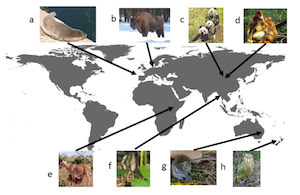
Panda image by KAM_1958, Wikimedia Commons. Mediterranean seal image by M. Cedenilla, CBD-Habitat.
The tendency to place protected areas in habitats that are less attractive to humans because they are not very productive may be the reason why many species remain threatened and continue to decline.
In a new study published in Conservation Science and Practice, an international team of researchers dubs this phenomenon the “Protected Area Paradox.” They contend that despite the growth in both marine and land-based protected areas globally, the attempt to conserve species in suboptimal habitats is yielding poor outcomes.
“Species that live in these types of habitats are known as refugee species and, in general, they suffer lower densities and fitness,” said Graham Kerley, lead author of the study and a professor at the Nelson Mandela University in South Africa. “This is because the species ends up living, not in the habitat most favourable to it, but in the habitat least favourable to the threats that caused its decline”.
To back this hypothesis, Kerley and his colleagues use the example of the giant panda, the world’s most iconic conservation symbol and a species that is still highly vulnerable, with a global population of fewer than 2,000 individuals.

A global overview of currently identified animal refugee species, where conservation management confines species to suboptimal habitat (a) Mediterranean monk seal, (b) European bison, (c) giant panda – this study, (d) snub-nosed monkeys (five species), (e) hirola, (f) Annamite striped rabbit, (g) New England mouse, (h) kakapo.
“It has been demonstrated that giant pandas have moved to high altitude bamboo forests and changed their diet recently, that is, in the past 3,500 years, which is pretty recent when we are talking about a species like this one. Previously, they had a broader range of habitats, including warmer/moist subtropical habitats,” Kerley said. “We believe that the shifts reflect a retreat to ecologically suboptimal refuges in the face of habitat loss and other human threats.”
Since these changes in species’ diets and habitats can happen over the course of decades, centuries or millennia, many conservationists believe that this is how things have always been. Thus, they focus their work on keeping threatened or vulnerable animals and plants in the suboptimal habitats where they are currently found or they create reserves with similar conditions.
“In other words, generations of conservation managers have been misjudging as optimal the marginal habitats where a species occurs, simply because it has persisted there,” said Daniel Pauly, co-author of the study and the Sea Around Us’ principal investigator at the University of British Columbia’s Institute for the Oceans and Fisheries. “This is what I call ‘the shifting baseline syndrome,’ which, in this case, hinders the critical assessment of current conservation efforts and the exploration of alternative approaches.”
The researchers believe that it is crucial to overcome the shifted baselines of conservation managers and scientists so that it is possible to identify who else is a victim of refugee species status.
“We predict that many of the species in protected areas are refugee species,” Kerley said. “Thus, we need urgent action to allow improved conservation management.”
The study “The Protected Area Paradox and refugee species: the giant panda and baselines shifted towards conserving species in marginal habitats” was published today in Conservation Science and Practice. Co-authors include Susanne Shultz from Manchester University in the United Kingdom; Mariska te Beest from Utrecht University in The Netherlands; and Joris P.M.G. Cromsigt from the Swedish University of Agricultural Sciences in Sweden.


